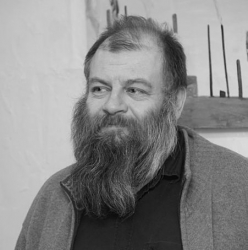
Ivan Sotnikov (1961-2015) was born and raised in St Petersburg, and studied art and photography. In the early 1980s he founded, along with Novikov, the New Artists (Novye Khudozhniki) group, making wild paintings influenced by German Expressionism, Pop Art and Primitivism. First operating out of a communal flat, they held a series of influential exhibitions and parties, combining fine art with youth culture, music, cinema, fashion and performance. The springboard for the group’s foundation was the now proverbial creation of a “zero object”. In the spirit of Dada and the absurd, Sotnikov and Novikov declared а rectangular cutout within an exhibition panel to be a work of art, a “zero object,” describing it as “a product of a pure creative act for which its authors did not exert any effort apart from their wish to create such an object”.
Art critic Ekaterina Andreeva observed that, for Sotnikov, “zero object” was a way toward the avant garde’s beyond-sense language, which could be used as a clean slate for experiment and creation of new art. For Sotnikov, the clean slate meant adopting the crude vocabulary of folk art and bringing it into the domain of high art. The artist accepted and maintained this emphatically simple style, bared down to basic, logo-like forms, traditional materials and a harmonious palette throughout his career. The subjects are largely confined to nudes, cars, planes, fir trees, fishes, flowers and landscapes.
Sotnikov’s early works, from the 1980s and1990s, depict nudes painted on supports of varying kinds and shapes. The limited range of subjects allows the artist to experiment with colour, composition and mood. Fir trees, for example, are loved in Russia because of their natural abundance and association with Christmas. Sotnikov’s trees are what you would expect to see in children’s drawings: frontal, large, pyramidal; with the spikes of branches cascading from the narrow top towards the wide bottom. Sometimes the trees stand singular and regal, taking up the entire painting; sometimes they are bunched up in a forest, but in all cases they display their distinct and strong characters, defined by the artist’s mood and his skill with the brush.
According to Andreeva, Sotnikov stood out among the group because of his joyful attitude towards the world. In 1996, he was ordained as a Russian Orthodox priest and from the late 1990s served in a parish in the village of Rogavka situated between Novgorod and St Petersburg. He later studied at the Orthodox Saint Tikhon Theological University, Moscow. Despite his new calling, he continued to paint; the works from the latter part of his career are as naive, open and inventive as those that marked his secular life, showing virtually no sign of his religious occupation. He spent his summers with his family in Montenegro, where he painted holiday boats, seascapes and mountains. This body of work was recently exhibited in Dukley European Art Community in Kotor.
When the artist became terminally ill, subjects of death and sickness entered his work, but the lighthearted spirit of joyfulness remained intact. In ‘Name the Benadryl’, painted in 2015, the last year of his life, Sotnikov asks the viewer to find Benadryl among many pills attached to its surface. Perhaps this work is the best monument to the artist’s indomitable spirit, filled with humour and with no trace of morbidity.
